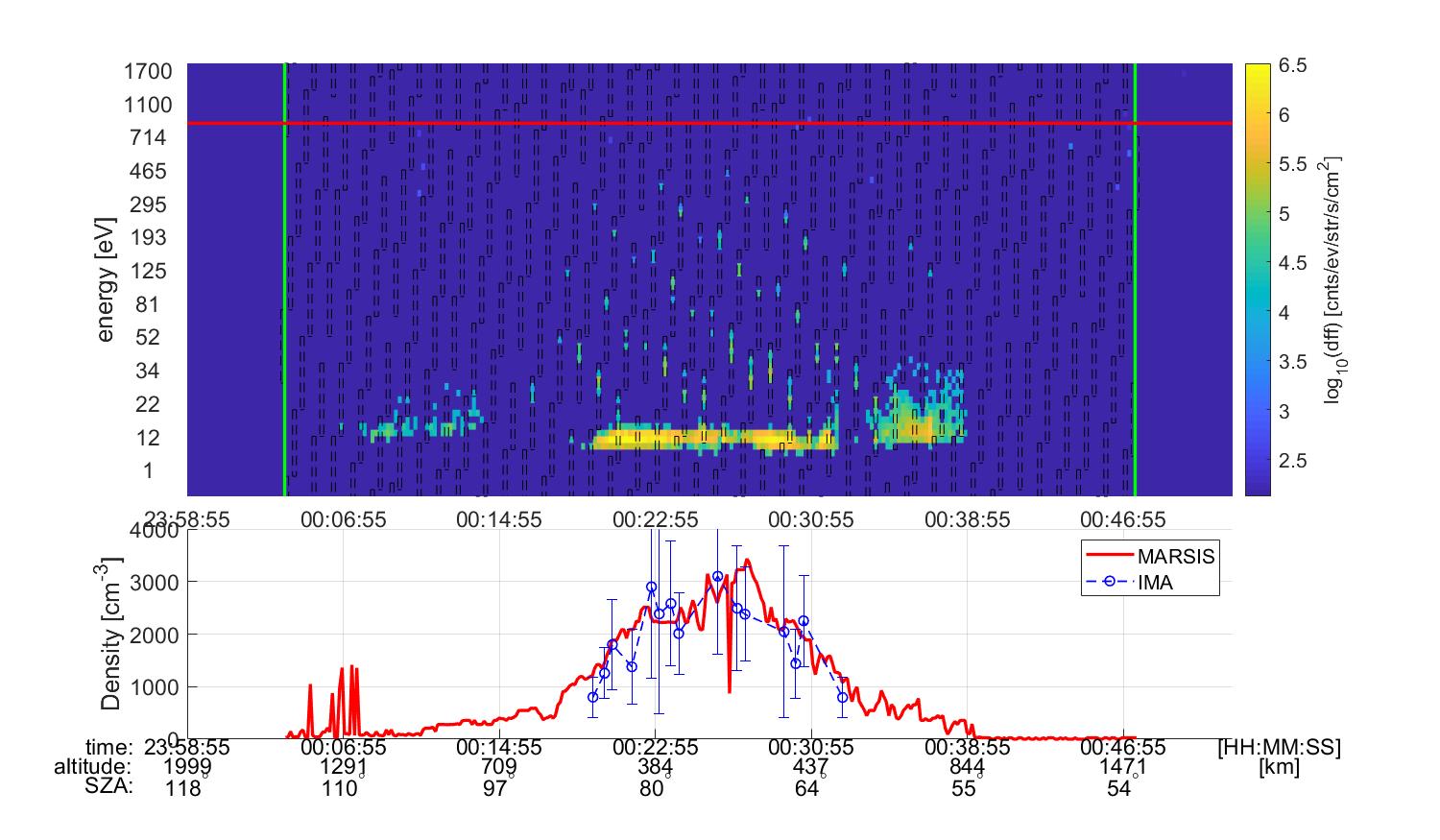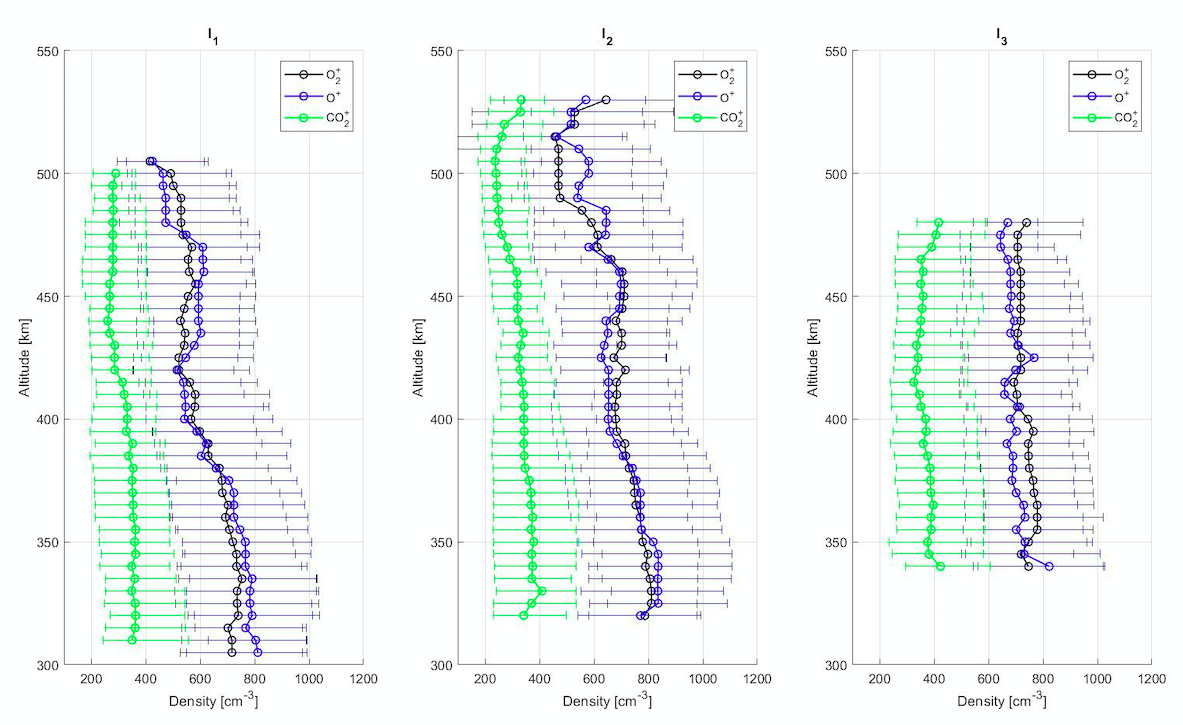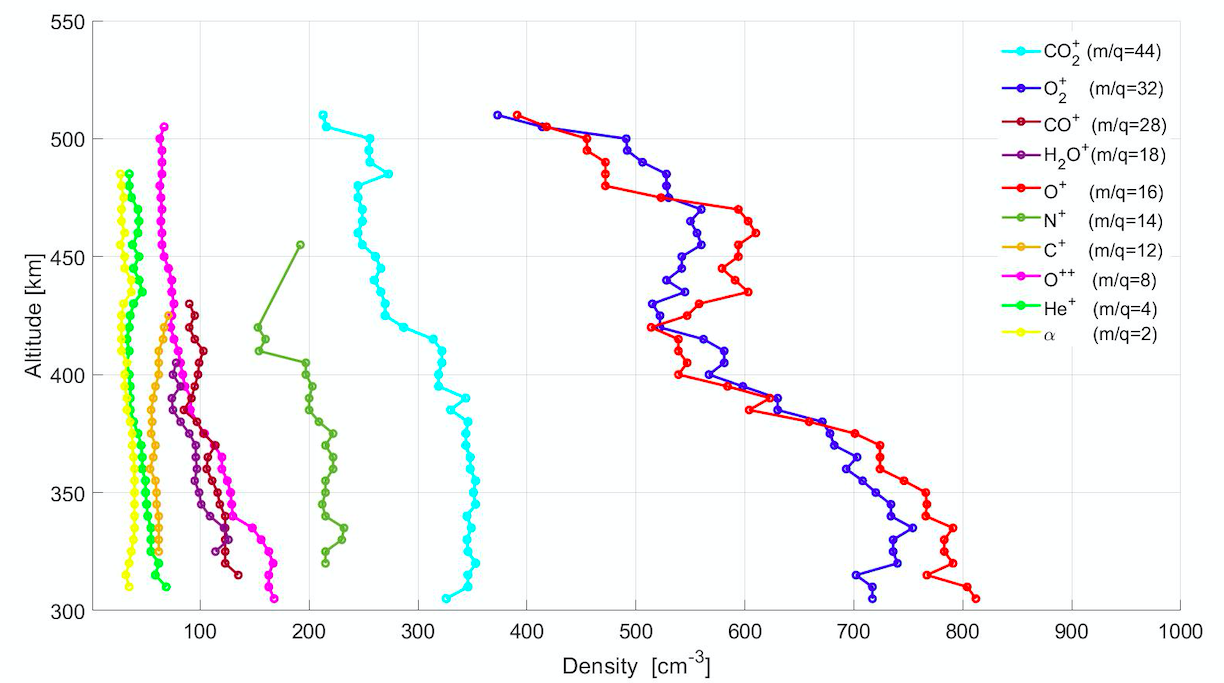Sounder accelerated ions: a new technique revealing new ionospheric properties as observed by Mars Express
- 1Swedish Institute of Space Physics, Kiruna, Sweden (stas@irf.se)
- 2ESA, ESTEC, Noordwijk, Netherlands
- 3INAF, Bologna, Italy
- 4ESA, ESAC, Madrid, Spain
- 5U. of Leicester, Leicestershire, GB
Interaction of a spacecraft with ambient plasma results in charging of the spacecraft to a potential of the order of the electron temperature. This is an issue for the ion measurements in the low altitude Martian ionosphere, since the potential energy of the ions in the spacecraft’s electric field is comparable to their thermal energy. However, the unique Mars Express payload makes possible the use of an innovative technique to study this low energy ionospheric population around the spacecraft. It has been discovered that operating the radar MARSIS (Mars Advanced Radar for Subsurface and Ionosphere Sounding) onboard Mars Express results in acceleration of the local thermal ions to energies up to 800 eV. Accelerated ions are readily detected by the ion detector of the Analyzer of Space Plasmas and Energetic Atoms (ASPERA-3). The analysis of these ASPERA-3 observations showed that that the voltage applied to the MARSIS antenna causes charging of the spacecraft to several hundreds of volts by the electrons of the ambient plasma. Individual observations of accelerated ions consist of almost mono-energetic ion beams that allow measuring densities of the main (O+, O2+ and CO2+) and even minor (O2++, C+, CO+) ionospheric thermal populations. This novel technique of active sounding opens new possibilities to study the Martian ionosphere.
From 2007 to 2016 2,528 Mar Express orbits were found to exhibit sounder accelerated ions (SAI). Created catalogue of the SAI events contains more than 50,000 SAI entries. This allowed to study the mechanisms that causes acceleration of thermal ions in the vicinity of an active transmitter in a plasma with no strong magnetic led. Based on it, a model was developed, that allows to estimate density of cold ionospheric ions from SAI observations.

Figure 1 shows an example of the ion density retrieved using the developed method. Top panels show the ion differential flux measured by IMA. Cold ionospheric plasma is visible as an intense signal at energy close to 10 eV. SAI are present as intense periodic disturbances within energy range between 30 and 800 eV. Bottom panels show comparison of the local electron density estimated using MARSIS ionograms and the ion density estimated from the SAI observations. As one can see, values are in a good agreement and follow similar dependence on altitude and SZA. Both methods show peak of the plasma density close to the periapsis.
Acceleration of the ionospheric plasma above thermal energy facilitates determination of the ion composition by IMA. Figure 2 shows altitude profiles for different ionospheric constituents measured using SAI by MEX. At the altitudes above 300 km main ionospheric species are O2+ and O+ . Corresponding densities decrease from 750 pp/cm3 at 300 km to 400pp/cm3 at 500 km. It is interesting to note that at the altitudes 300-350 km density of O+ is higher than the density of O2+ while on higher altitudes situation is opposite. Similar results were found by MAVEN.

Figure 2: Examples of altitude profiles of different ionospheric constituents obtained from the SAI observations.
Extensive database of the SAI covers more than one solar cycle enabling study of the variability of the Martian ionosphere. Figure 3 shows altitude profiles of the CO2+, O2+ and O+ for the periods of dierent EUV irradiance. For all of the species density increases with increase in EUV irradiance. However different species have dierent response to the increase in EUV irradiance. For the period with low EUV (left panel) density of O+ is higher than that of O2+ at the altitudes below 400 km. In the case of medium EUV flux (middle panel) the densities of these to species are almost equal. For the period of high EUV flux density of O2+ is higher.
SAI database can be used to study the impact of the Martian magnetic anomalies on the ionospheric densities. Figure 4 shows altitude density profiles for regions with closed and open magnetic field lines. Both profiles exhibit similar behavior: ion density decreases by 25% as altitude increases from 300 to 450 km. A notable difference is that the ion density above regions with open magnetic field line is much higher. This result is in agreement with the previous studies. In the open field regions, the ionosphere is more inflated than in other regions since it is easier here for plasma at lower altitudes to diffuse upward. In the regions with strong horizontal field situation is different. In these regions, horizontal drifts due to plasma pressure gradients move plasma particles toward the local magnetic equator where plasma gets trapped. The effects of this trapping on plasma density become more apparent above 170 km, where the effects of collisions between plasma and the neutral atmosphere become negligible compared with plasma transport processes. The vertical transport is inhibited by a horizontal magnetic field resulting in depletion of the ionosphere above these regions.

Figure 3: Altitude proles for O2+, O+ and CO2+ estimated from the SAI observations. Left panel: altitude profiles obtained for the period of the low EUV flux, middle panel - for the period of medium EUV flux, right panel - the period of high EUV flux.

Figure 4: Altitude profiles of the averaged ion density above the regions with strong magnetic field. Red line - modeled magnetic field angle is horizontal. Blue line - modeled magnetic field normal angle is radial.
Particle acceleration by sounders in the planetary ionospheres is a type of active experiments of great interest. These phenomena are a result of routine operation of satellite-borne sounders and do not require any additional spacecraft or mission resources, an important factor for planetary missions with scarce resources. Sounder accelerated ions detected on Mars Express enabled development of the method that allows to retrieve ion density and composition of cold ionospheric populations. This method was used to study the variability of the Martian ionosphere composition within solar cycle. In addition it was used to study of the crustal magnetic field on the ionospheric density.
How to cite: Voshchepynets, A., Barabash, S., Holmström, M., Titov, D., Orosei, R., Martin, P., and Sanchez-Cano, B.: Sounder accelerated ions: a new technique revealing new ionospheric properties as observed by Mars Express, Europlanet Science Congress 2022, Granada, Spain, 18–23 Sep 2022, EPSC2022-700, https://doi.org/10.5194/epsc2022-700, 2022.

